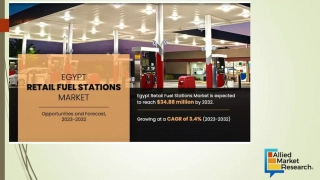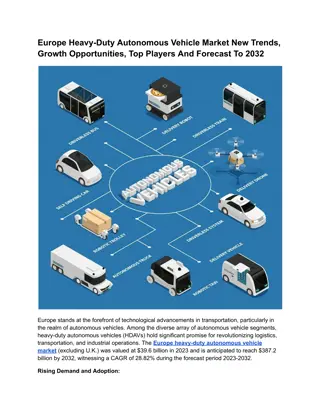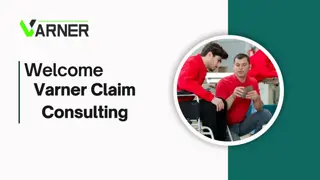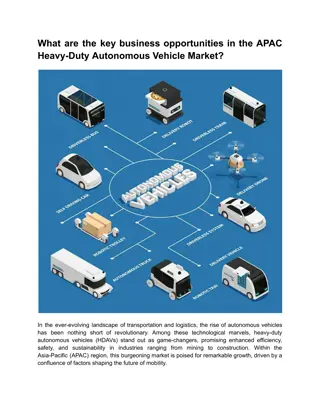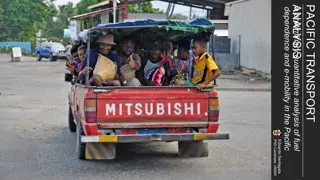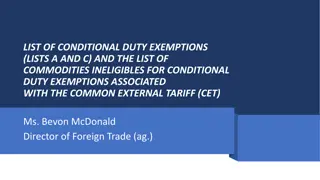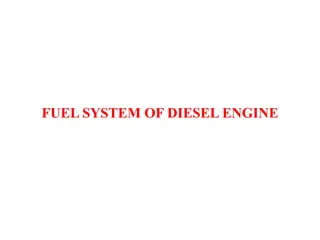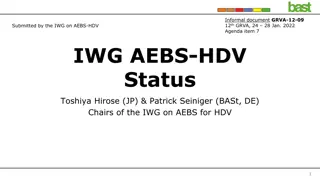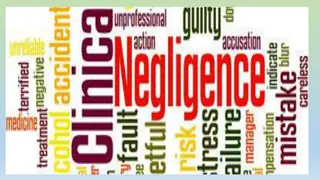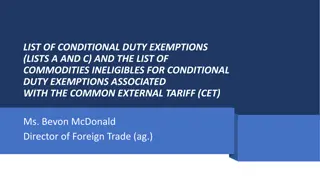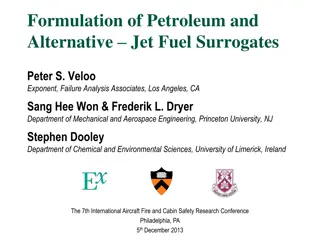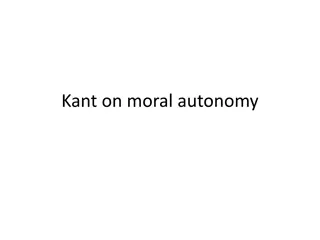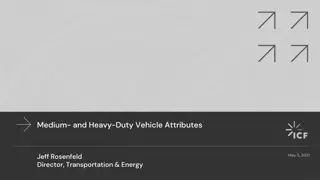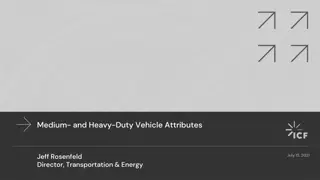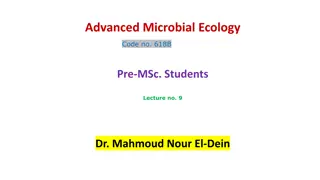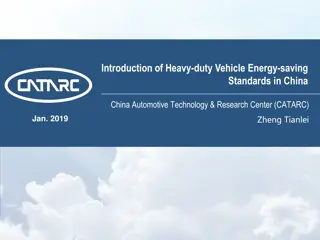Heavy Duty Vehicle Fuel Efficiency Workshop Highlights
Workshop discussions covered the harmonization of fuel efficiency regulations and measurement methodologies for heavy-duty vehicles. Stakeholders shared insights on common challenges and opportunities for standardization across regions like the US, EU, China, and Japan. Emphasis was placed on starting with harmonizing measurement methods as the initial step towards alignment. The workshop aimed to address the complex variations in heavy-duty vehicle design, regulations, and measurement standards to improve efficiency and environmental impact.
Uploaded on Sep 16, 2024 | 1 Views
Download Presentation

Please find below an Image/Link to download the presentation.
The content on the website is provided AS IS for your information and personal use only. It may not be sold, licensed, or shared on other websites without obtaining consent from the author.If you encounter any issues during the download, it is possible that the publisher has removed the file from their server.
You are allowed to download the files provided on this website for personal or commercial use, subject to the condition that they are used lawfully. All files are the property of their respective owners.
The content on the website is provided AS IS for your information and personal use only. It may not be sold, licensed, or shared on other websites without obtaining consent from the author.
E N D
Presentation Transcript
History of HD FE Workshop FE Workshop, 80thGRPE, Geneva 14 January 2020
1st WS of HD FE Harmonization First Workshop organized during in GRPE of Jan. 2019 kicked-off HD FE Harmonization with participation from various stakeholders. Latest information on regulations and measurement methodologies was provided from/shared among EC, China, Korea, Japan and ICCT in this WS, followed by views/opinions exchanges on the harmonization. GRPE main meeting concluded that OICA organize next WS during GRPE in January 2020 to further promote our activities on harmonization.
Agenda of 1st WS Cancelled Cancelled
Summary of OICA at 1st WS Heavy duty vehicle has a lot of variation and is usually shipped without rear body. FE regulation and measurement method have different feature from LD regulation, for example use of simulation. HD regulations in each area has different feature based on its policy or vehicle usage, but there are many common part especially on measurement method. It seems that FE measurement method has less difficulty to harmonize. OICA/GEPE recommend to start from the harmonization of measurement method as first step. 4
FE Elements in each Area Status of each region US Phase Item Sub-item Japan (Next FES) EU China Weight Cab type Vehicle type Weight Vehicle type Weight Categorize Axles, Configurations, Weight CO2 g/ton-km g/passenger-km gal/1000ton-mile CO2 g/ton-mile FE Unit L/100km km/L FES value around 2025 is decided this year FE Criteria Consider after labeling Becomes strict every 3 years Becoming strict in 2019 ARB tangents 55,65 mph Mode 10type C-WHVC JE05, Inter city 70points for 55,65 mph Steady state Engine Map 100 points 81 points 51 points Cycle average map NA (Include chassis dyno) Engine Transient Engine Map NA NA NA (Include chassis dyno) Transient coefficient WHTC correction factor tool Include Cycle average map Table value 3% For Hybrid, AT, AMT by simulation For Hybrid, AT, AMT by powertrain test For Hybridand AMT by simulation Powertrain FE map with powertrain NA Table value or Measurement Table value or Measurement NA (Include chassis dyno) T/M efficiency Table value Table value or Measurement NA (Include chassis dyno) Table value or Measurement Measurem ent method Gear AT parts efficiency Include powertrain test method Table value or Measurement Table value or Measurement NA (Include chassis dyno) Axle efficiency Table value Coast down Wind tunnel CFD Table value (Opt. Wind tunnel or coast down) Constant speed Simulation Coast down or Constant speed Aero Drag measurement Aero Drag Vehicle select method Family Concept ? ? Family Concept (EC) 1222/2009 = ISO28580 Ranking by ISO28580 Resistance measurement ISO28580 Table value Tire Direct input of tire RRC for each vehicle Direct input of tire RRC for each vehicle Averaging tire RRC to be used Resistance select Method - Generic or OEM-specific Only installed when measuring engine auxiliary parts ? NA Simulation Input data & Logic Input data and driver model is different based on item above Determine FE value 5 Must family-representative vehicle Chassis dyno NA NA NA
HD FE regulatory schedule in each area Year '13 '14 '15 '16 '17 '18 '19 '20 '21 '26 22 23 24 25 27 28 29 30 2025 HD FE standard 2015 HD FE standard JPN GHG Phase I Phase II US FE Phase I Labeling of FE value EU 2025 target 2030 4th stage 2nd stage 3rd stage 1st stage CHNA 2nd Stage of constant speed test Phase 1 (EuroIV) Phase 2(BSIV) India Phase1 (EuroVI) Phase1 (BSVI) Possibility of Rule making Legislation Under consideration 6
Steps for Harmonization Elements Sub-Elements Issues Examples Transport efficiency or Easy to understand for everybody - km/L - ton.km/L FE Unit - Criteria Second step Limit of FE value or average value - Averaged by number of sales - CAF Others Simpler category is desired, but needs to reflect to real world compexity - Vehicle type (Tractor, bus .etc) - GVW, type of cabin Vehicle classification - Accuracy vs. cost of measurement Contribution for FE - Engine, T/M - Aero dynamic and rolling resistance Items of FE effect - Vehicle speed base or road data base less complexity vs real world reflection - Combination of two cycles - Unique mode for each vehicle type Driving Mode - Chassis dynamometer Should Chassis dynamometer measurement be used First step Should simulation be used Driver model contents - Common calculation logic - Difference of steady and transient Simulation Number of measurement points Transient operation effect - CO2 measurement by engine - Engine FE map and simulation Engine measurement Measurement Method Measurement methods Selection of vehicle type, rear body - Coast down, steady speed drive - CFD - Wind tunnel Aero dynamic measurement - Common tyre measurement method - How to handle a number of axis Tyre rolling resistance Measurement method, labeling 7 Measurement method - Driveline drag, Auxiliary drag, etc Others
Key points and Conclusions of 1st WS Several Stakeholders see (significant) benefits on analyzing what level of harmonization could be achieved globally on Fuel Efficiency regulation. Contracting Parties should consider that in order to make the different regulatory approaches comparable efforts should be started to begint with the harmonization of measurement methodologies. As discussed today, Regulations in each area have different features based on policy or vehicle usage, but there are common parts especially on measurement methodologies that could be harmonized between the different regions. In interest next steps on this topic, existing methodologies and regulations must be analyzed and studied thoroughly and shall be used as a basis to define global approach. Categorization of Heavy duty vehicles in each region may prove to be challenging to harmonize, also fuel efficiency cycles and simulation approaches. 8
However we have seen that some methodologies and instrumentation could harmonized between different contract parties. Industry suggest two step approach in order to have an effective effort that would allow to begin harmonization efforts, these efforts should begin as soon as possible. Deviation where necessary to accommodate the regional conditions or technical differences or in the interests of improving currently set methodologies must be considered. Any such developments should be guided by robust technical analysis Further countries/ regions interested in introducing FE legislation for HDV should consider implementing a harmonized approaches
OICA Comment in GRPE of May 2019 First Workshop First Workshop organized during the last GRPE kicked-off HD FE Harmonization: OICA would like to express gratitude for participation from various stakeholders. Latest information on regulations and measurement methodologies was provided from/shared among EC, China, Korea, Japan and ICCT in this WS, followed by views/opinions exchanges GRPE main meeting concluded that OICA organize next WS during GRPE in January 2020 to further promote our activities on harmonization. on the harmonization. Next Workshop While each government is implementing and/or upgrading FE regulation, OICA recognize that the acceleration of harmonize with the coordination among each government is required. Therefore OICA is pleased to make our effort to organize effective WS. OICA would like to request all stakeholder s active participation in the next WS where constructive discussion for harmonization is expected.
OICA Comment in last GRPE First Workshop First Workshop organized during the last GRPE kicked-off HD FE Harmonization: OICA would like to express gratitude for participation from various stakeholders. Latest information on regulations and measurement methodologies was provided from/shared among EC, China, Korea, Japan and ICCT in this WS, followed by views/opinions exchanges GRPE main meeting concluded that OICA organize next WS during GRPE in January 2020 to further promote our activities on harmonization. on the harmonization. Next Workshop While each government is implementing and/or upgrading FE regulation, OICA recognize that the acceleration of harmonize with the coordination among each government is required. Therefore OICA is pleased to make our effort to organize effective WS. OICA would like to request all stakeholder s active participation in the next WS where constructive discussion for harmonization is expected.


